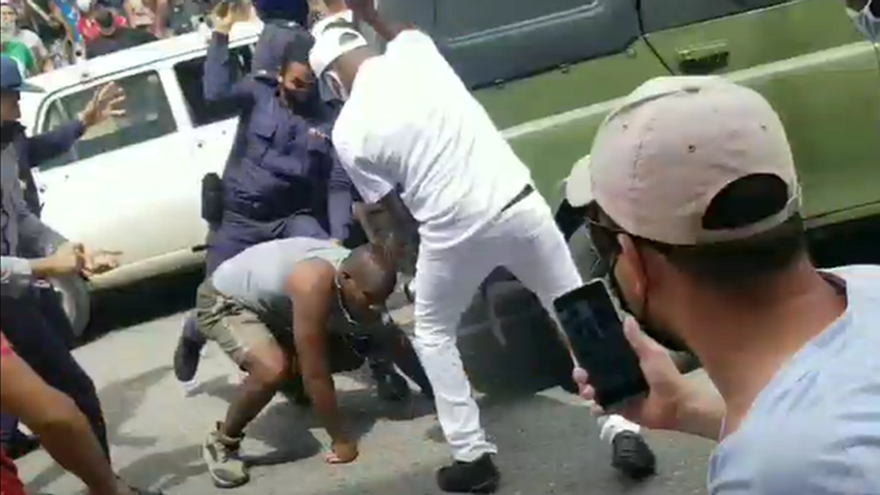
![]() 14ymedio, Havana, July 16, 2021 — This Friday the Cuban Masons of the Supreme Council of the 33rd Degree condemned the performance of Miguel Díaz-Canel at the head of the country “for calling, inciting, and ordering a violent confrontation against the Cuban people” after the protests in recent days.
14ymedio, Havana, July 16, 2021 — This Friday the Cuban Masons of the Supreme Council of the 33rd Degree condemned the performance of Miguel Díaz-Canel at the head of the country “for calling, inciting, and ordering a violent confrontation against the Cuban people” after the protests in recent days.
In a letter addressed to the Cuban leader, the Masons rejected the arrests and violence unleashed by the regime against “peaceful protesters and citizens who think contrary to the system” that Díaz-Canel represents.
They also declared their disapproval of the usual justification used by the regime to defend itself from the crisis “the country has been plunged into”, blaming “external reasons (the US ’blockade’ [i.e. the embargo] towards Cuba) without acknowledging the responsibility and ineffectiveness of the Government.”
Similarly, in the letter signed by IPH José Ramón Viñas Alonso, Sovereign Grand Commander of the Supreme Council, he denounced the idea that the social outbreak on the Island “shows the manifest nonconformity in which the country lives.”
The Masons made it clear that their position was to be “on the side of the people” and mentioned that they belong to an institution that years ago was one of those that most “influenced the independence and society of this country.”
They cautioned that the letter does not represent disrespect for Díaz-Canel’s inauguration as president of Cuba, but it is “a sincere and necessary position” for what the country is experiencing.
After the dissemination of the letter, Viñas Alonso was summoned to the police station on Zapata and C streets in El Vedado, Havana, where he was accompanied by a group of Masons from the same Lodge, as confirmed by the writer and fellow Mason Angel Santiesteban.
The Supreme Council’s position came after a statement from the Grand Lodge of Cuba characterizing as “disturbing” the excessive use of force by those in charge of keeping order.
“Today we watch with sadness as something that was foreseeable due to the discontent and deficiencies among the population has materialized in demonstrations throughout the country,” stated the Grand Lodge, and labeled as “unacceptable the call for a confrontation between Cubans.”
They also stated that they are “on the side of the Cuban people” and advocate “for peace, harmony, and social justice.” “We urge that tolerance, the search for truth, and brotherly love prevail under any circumstances.”
Masons have had a large presence in Cuban history, especially in the struggles for independence. Most of the heroes of that feat were Masons, like Máximo Gómez and Antonio Maceo. Even José Martí’s status as a Mason, which was in doubt for decades, was finally confirmed.
But with the passing of the years and the nationalization of the last half century, the social and political prominence of the Masons decreased notably, along with the number of their members. At present it is estimated that there are slightly more than 27,000 Masons distributed in 320 lodges across the Island.
Last Sunday, July 11, the streets of Cuba were abuzz with people who came out to protest against the regime. The peaceful mobilization started with a demonstration in the municipality of San Antonio de los Baños, in Artemisa, which was broadcast live on Facebook until the connection was cut off by the regime.
In all the gatherings, reported in various provinces such as Matanzas, Camagüey, Santiago de Cuba, Cienfuegos, and Havana, cries of “down with the dictatorship” and “freedom” were heard. The Government cut the internet connection throughout the country to prevent Cubans from uploading videos to social media that showed what happened in the demonstrations, and also showed the repression of the participants.
Other protests were also reported during Monday and Tuesday in different parts of the country, but the dictatorship increased the wave of repression against the protesters. On social media, reports of house-to-house detentions and police violence multiplied.
So far, there are no official figures for injuries, deaths, and arrests from the protests. The government has only reported the death of a 36-year-old man who participated in a protest on Monday in the slum neighborhood of La Güinera, in Havana. Civil society organizations have counted about 5,000 people arrested or investigated since July 11, including 120 activists and journalists.
Translated by Tomás A.
____________
COLLABORATE WITH OUR WORK: The 14ymedio team is committed to practicing serious journalism that reflects Cuba’s reality in all its depth. Thank you for joining us on this long journey. We invite you to continue supporting us by becoming a member of 14ymedio now. Together we can continue transforming journalism in Cuba.
